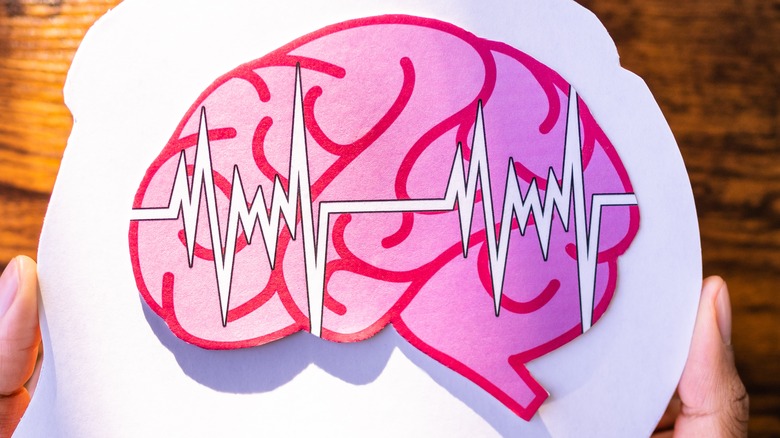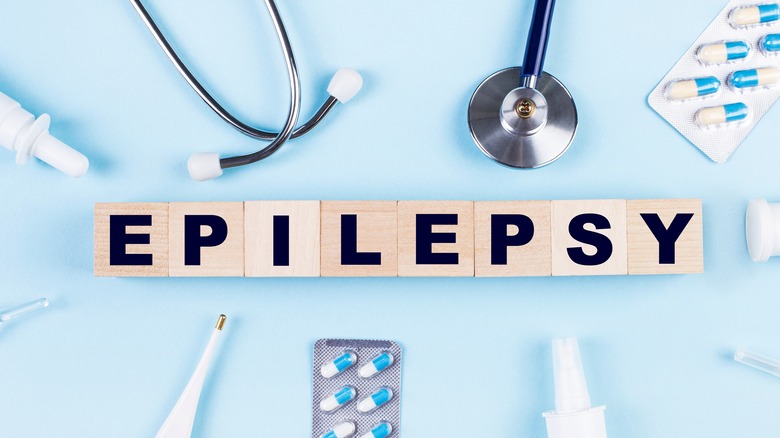Epilepsy Explained: Causes, Symptoms, And Treatments
As described by the American Association of Neurological Surgeons (AANS), epilepsy is a disorder in which the normal electrical signaling in the brain is disrupted, causing repeated seizures. Seizures are characterized by sudden bursts of excessive electrical discharge that may change awareness, movements (e.g., jerking) or sensations. A person is considered to have epilepsy after having had two or more seizures without a known trigger such as alcohol withdrawal or extremely low blood sugar. Epilepsy is an ancient disorder that can be traced back to 4000 BCE, per the World Health Organization. Patients with epilepsy have faced discrimination and social stigma for millennia — and still do, to this day.
There are two basic types of seizures: focal onset seizures that begin in one area on one side of the brain, and generalized onset seizures that affect both sides of the brain at once (via the Cleveland Clinic). A person with focal onset seizures may be either awake and aware (e.g., jerking of arms or legs) or unaware and confused (e.g., staring blankly). Generalized onset seizures can vary widely from brief episodes of "staring into space" or muscle jerking to convulsions. Convulsions, once called grand mal seizures, involve continuous muscle jerking up to 5 minutes and loss of consciousness and falling. In addition, drooling, tongue biting, and loss of bowel and bladder control may also occur with convulsions.
Prevalence and incidence of epilepsy
According to a 2021 study in the Journal of Clinical Neurology, roughly 70 million people have epilepsy globally, with the vast majority of patients living in developing countries.
Among neurological diseases, only stroke and dementia are more common than epilepsy. The prevalence of epilepsy is greater in men than in women, and its incidence increases with age in parallel with the development of strokes, brain tumors, and Alzheimer's disease (via the American Association of Neurological Surgeons). Thus, epilepsy is more common in older people over the age of 65; however, it is also highly prevalent in very young children under the age of 15. Per the Epilepsy Foundation, new cases of epilepsy occur annually in about 48 out of every 100,000 people.
Research has shown that in recent decades, the incidence of epilepsy has declined in the youngest age groups, but increased in the elderly (via Neuroepidemiology). These trends are likely related to improvements in sanitation, perinatal care, and infectious disease control for the young, and longer life expectancy with accompanying age-related diseases, as well as increased detection, in the old.
What causes epilepsy?
While not contagious, epilepsy can occur in anyone (per the Epilepsy Foundation). For about half of the people with epilepsy worldwide, no cause has been identified yet.
As reported by the Mayo Clinic, a number of different causes have been identified for the other half of people with epilepsy. For example, a strong genetic component is more likely if there is a family history of epilepsy. In some cases, a person who inherits a genetic variant gene may still be affected by environmental triggers, and perhaps even more so. Epilepsy can be caused by brain trauma from head injuries (e.g., auto accident) or brain tumors, as well as from stroke, which is the chief cause of epilepsy in people over age 35. Infections such as meningitis, HIV, viral encephalitis and parasitic infections can also trigger seizures. Other causes of epilepsy include developmental disorders (like autism) and brain damage occurring before birth. Prenatal brain injury can be caused by loss of oxygen, poor nutrition, or maternal infections.
According to the Epilepsy Foundation, a certain type of epilepsy characterized by sudden and severe onset of seizures may have an autoimmune cause. People at greater risk of developing autoimmune epilepsy include those with a history of another autoimmune condition (e.g., rheumatoid arthritis, autoimmune thyroiditis, inflammatory bowel disease, and lupus) or a history of cancer. Having a parent, brother, sister, or child with an autoimmune disorder is also associated with an increased risk of developing autoimmune epilepsy.
Signs and symptoms of epilepsy
As described by the World Health Organization (WHO), signs and symptoms of epilepsy are determined by the specific area of the brain initially affected by disrupted electrical functioning, as well as the extent of its progression into other areas. The hallmark of epilepsy is recurrent seizures which cause symptoms that vary according to the type of seizure, reports the Cleveland Clinic.
Symptoms can manifest as a temporary loss of awareness or responsiveness. Some people with epilepsy seem confused and have difficulty talking or understanding, appearing to blankly stare into space. Others may lose control of their muscles, causing jerking, lip-smacking, hand rubbing, finger motions, or chewing motions. Still others may experience rapid heart rate and/or breathing, indigestion, goosebumps, numbness or tingling, sensations of heat or cold, and feelings of anxiety, dread, fear, and deja vu. With epilepsy, hearing, vision, taste, and smell may change as well.
Seizures that are more intense and prolonged can cause bodily harm, including fractures and bruising (via WHO). In fact, people with epilepsy, particularly those residing in low- and middle-income countries and rural areas, have a threefold greater risk of dying prematurely than the general population does. In many cases, the causes of death in people with seizures (e.g., falls, drowning, burns, and protracted seizures) are preventable.
Risk factors for epilepsy and seizure triggers
A number of risk factors are associated with a greater likelihood of developing epilepsy, per the Mayo Clinic. For example, children and older adults have an increased risk of epilepsy relative to other age groups. People with a family history of epilepsy, a long-fever-associated seizure as a child, or another nervous system disorder are also at risk of developing seizures. Head injuries, brain infections (e.g., meningitis), dementia, and blood vessel diseases such as stroke increase seizure risk as well.
Additional risk factors for epilepsy noted by the American Association of Neurological Surgeons (AANS) include premature birth or low birth weight, trauma during birth, seizures during the first month of life, brain tumors and bleeding into the brain, abnormal structure of the brain at birth, cerebral palsy, mental disabilities, and alcohol or drug abuse.
Apart from risk factors, a variety of factors make a person with epilepsy more prone to having a seizure (via Medical News Today). These seizure triggers include stress, sleep deprivation and fatigue. Per the Cleveland Clinic, other seizure triggers include hormonal changes, illness (e.g., fever), flashing lights or patterns, skipping meals, dehydration, overtraining, certain foods and compounds like caffeine, specific medications (e.g., the antihistamine diphenhydramine), certain times of the day or night, and missing doses of anti-seizure drugs. Tracking seizures to discover patterns and identify triggers is recommended.
Diagnosis of epilepsy
Diagnosing epilepsy is often challenging because seizures typically occur outside of medical settings where they would otherwise be observed and monitored (via Johns Hopkins). Effective treatment of epilepsy requires an accurate diagnosis to identify and locate any lesion within the brain that may be triggering seizures.
First, the physician reviews symptoms and medical history, then ordering appropriate tests to determine the cause of seizures. Per the Mayo Clinic, the evaluation may include a neurological exam to assess motor abilities, mental function, and behavior. Various blood tests may detect signs of infection and genetic conditions. An electroencephalogram (EEG), the main diagnostic procedure for epilepsy, can spot brain abnormalities. Electrodes attached to the scalp of the patient record changes in normal patterns of brain waves, even when the patient is not having a seizure. The test can ascertain the type of seizure a person is having and rule out other conditions.
Computerized tomography (CT) scans and magnetic resonance imaging (MRI) can uncover abnormalities in the brain that may be triggering seizures. By using a radioactive tracer, a positron emission tomography (PET) scan can distinguish areas of low metabolic activity in the brain that may correspond to where seizures are occurring. If an MRI and EEG are unable to locate the origin of seizures in the brain, a single-photon emission computerized tomography (SPECT) test can pinpoint the precise brain region of seizure activity by detecting changes in blood flow during a seizure. Additionally, neuropsychological tests may be used to assess thinking, memory and speech skills.
Treatment of epilepsy
While epilepsy is not curable, treatments can help control seizures, states the Epilepsy Foundation. Typically, the first-line treatment for epilepsy are anti-epileptic drugs (AEDs), which effectively control seizures in about 70% of cases. Mostly administered orally, these medications include valproic acid (Depakene), carbamazepine (Tegretol), lamotrigine (Lamictal), and levetiracetam (Keppra), per Medical News Today.
According to the National Institute of Neurological Disorders and Stroke, surgery for epilepsy may be considered when at least two medications fail at controlling seizures, or if a brain lesion related to the seizures has been identified. Though surgery can appreciably reduce seizures in people with epilepsy, associated risks include cognitive impairment and physical disability. The most common type of surgery is a lobectomy, which involves the removal of the defined portion of the brain where seizures begin. If a lobectomy is not feasible, a series of cuts (referred to as a multiple subpial transection) are made to prevent spreading of seizures to other areas of the brain. In severe cases where damage affects only half of the brain, a hemispherectomy is performed to cut out half of the brain's cortex (outer layer). Thermal ablation is a less invasive type of surgery that delivers a set amount of energy to a targeted section of the brain, thus destroying brain cells causing the seizures.
For people with epilepsy who do not respond to medications or are unable to undergo surgery, electrical stimulation of the brain (e.g., vagus nerve stimulation, deep brain stimulation) is a treatment option.
The ketogenic diet and epilepsy
The ketogenic (keto) diet has been used to treat epilepsy for about a century, per a 2019 review of studies published in Nutrients. It is primarily used as a last resort treatment for people with epilepsy, mostly children, who do not respond to standard medications.
The hallmark of the keto diet is a very high intake of fat and a very low (4% of total daily calories) intake of carbohydrates. The extreme carbohydrate restriction flips on a metabolic switch that causes the body to preferentially shift from the utilization of glucose to the utilization of fatty acids and fat-derived ketone bodies (or ketones) for energy. Ketones generated from the keto diet replace glucose as the major fuel for the brain. Energy production in the brain is substantially increased by the keto diet. As a result, nerve cells function better and become more stress-resistant, increasing the seizure threshold. Another key mechanism of the keto diet is the increased synthesis of GABA, an important neurotransmitter that reduces electrical excitability in the brain and thereby helps to prevent the onset and spread of seizures.
A 2020 review of clinic trials published in the Cochrane Database of Systematic Reviews found that children on the ketogenic diet have up to a threefold greater likelihood of being seizure-free and up to a sixfold chance of slashing seizure frequency in half compared to children on standard treatment. A less restrictive and better tolerated modified Atkins diet also achieved significant seizure reduction in children (though not as much).
Managing epileptic seizures
As noted by the American Association of Neurological Surgeons (AANS), treatment with medications or surgery successfully manages seizures in most people with epilepsy, allowing them to lead ordinary, active lives.
Getting sufficient sleep and coping with stress by practicing yoga, meditation, biofeedback, and deep breathing exercises are lifestyle measures that can also help manage seizures (via the Cleveland Clinic). Other important lifestyle improvements can contribute to epilepsy management as well, including regular exercise (around 150 minutes per week), a nutritious diet, and moderation in alcohol use. Additionally, people with epilepsy should recognize and avoid seizure triggers and keep their doctor updated about any new medications that have been prescribed by other physicians, particularly antidepressants, antihistamines, and stimulants — all of which can interact with anti-epilepsy drugs or cause adverse reactions. Information about over-the-counter medications, vitamins and supplements, and any herbal products should also be revealed to the managing doctor.
While the likelihood of a woman with epilepsy to give birth to a normal, healthy baby is 90% or better (via the AANS), women with epilepsy who wish to get pregnant should first consult with their physician. The managing physician may reduce anti-seizure medications, since they can cause birth defects. However, severe birth defects are rare when the mother's seizures are carefully managed.
Complications of epilepsy
The suddenness of a seizure can be dangerous and sometimes even fatal, reports the Mayo Clinic. Falls during a seizure can cause fractures and serious head injuries while drowning occurs up to 19 times more frequently among people with epilepsy than the general population. Moreover, loss of awareness while driving can result in car accidents. Accordingly, some states mandate driving restrictions contingent on the driver being seizure-free for a defined period (from months to years).
Other potentially life-threatening but rare complications of epilepsy include status epilepticus, a long-lasting seizure (more than five minutes) that can cause permanent injury to the brain or death. Also, people with severe epilepsy and uncontrolled seizures are at high risk for sudden unexpected death in epilepsy, or SUDEP. The cause of SUPEP is unknown, and it accounts for about 1% of deaths among people with epilepsy.
As noted by Medical News Today, the prevalence of other chronic conditions (e.g., dementia, migraine, heart disease, and depression) is eight times greater in people with epilepsy than in the general population. Lamotrigine, phenytoin, phenobarbital, and other anti-seizure drugs can cause a skin rash, which can be severe and potentially fatal in 0.8% – 1.3% of adults. Meanwhile, emotional and social issues are particularly prevalent among children with epilepsy, per Johns Hopkins. Because of the hardship dealing with epilepsy, children may develop behavioral problems or learning disabilities at school.
Can epilepsy be prevented?
According to the World Health Organization, one in four cases of epilepsy are preventable. Safeguarding against head injury (e.g., wearing a helmet when bike riding) is first and foremost when it comes to preventing post-traumatic seizures. Pregnant women should seek perinatal care to reduce the risk of epilepsy from birth injuries. In cases of childhood epilepsy, the possibility of febrile seizures can be minimized by reducing the body temperature of a feverish child. Managing risk factors for cardiovascular disease is the recommended strategy to prevent stroke-induced epilepsy. These cardio risk factors include high blood pressure, diabetes, obesity, smoking, and excessive alcohol use. In low- to middle-income tropical areas of the world, the risk of parasitic infections such as neurocysticercosis that cause epilepsy can be reduced with good hygiene practices.
People with epilepsy, like the general population, should be encouraged to exercise, concludes a 2015 review of studies published in the journal Seizure. Exercise rarely triggers seizures. On the contrary, in people with epilepsy, exercise improves physical/mental health and social integration, while also reducing stress indicators and the number of seizures. Interestingly, beginning exercise at an early age builds up reserves in the nervous system that may reduce the susceptibility to seizures later in life.
Prognosis of epilepsy
According to the Merck Manual, about a third of people with epilepsy become seizure-free with proper treatment, which also cuts the frequency of seizures in half in another third.
A person with epilepsy is considered to be in remission after being seizure-free for 10 years, of which at least the last 5 years is off anti-seizure medications. Thus, with up to 80% of cases achieving long-term remission, the overall prognosis of epilepsy for the majority of affected people, against a benchmark of seizure freedom, is good (per a 2020 review of studies published in the journal Neuroepidemiology).
Nevertheless, people with epilepsy have a greater risk of dying prematurely than people who don't have it. Epilepsy-related deaths exact a considerable burden on public health. Deaths directly linked to epilepsy or seizures, many of which may be preventable, include sudden unexpected death in epilepsy (SUDEP), status epilepticus, and unintentional injuries.












